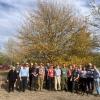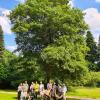Editor's Picks
Plant Focus
Poster presented at the XX International Botanical Conference, Madrid, Spain, July 21–27, 2024.
Authors:
Andrew L. Hipp1,2, Alan T. Whittemore1
Affiliations:
1. Herbarium and Center for Tree Science, The Morton Arboretum, Lisle, Illinois, USA
2. Committee on Evolutionary Biology, University of Chicago, Chicago, Illinois, USA
Abstract:
Plant biologists have debated the nature of oak species for more than 200 years. Opinions range from the opinion that oak species hybridize relatively rarely to the view that related oaks form syngameons, near-freely interbreeding complexes of species. Understanding species boundaries and gene flow in oaks is essential to conserving the ca. 425 global oak species on which humans and hundreds to thousands of arthropod, fungus, vertebrate, and plant species depend. We review published data on oak species boundaries based on multilocus nuclear data and conclude that most traditional oak species investigated are diagnosable as genomic cluster species. Nonetheless, individual oaks demonstrate a wide range of mixed-species ancestry, with as many as 20% of individuals averaged across studies admixed at a level of 10% or higher. We also review the burgeoning oak literature investigating adaptive introgression, the incorporation of alleles from one species into another through hybridization followed by generations of natural selection and backcrossing. species. In combination, these studies suggest that introgression often plays a creative force in oaks, increasing diversity and offering a potential genetic rescue for species on the verge of extinction. Several outstanding questions demand additional research. How important is multispecies introgression in oaks, which often grow within pollination distance of a numerous reproductively compatible species? Are there conditions under which we expect genetic swamping to pose a strong risk to endangered oak species, and if so, does adaptive introgression significantly offset this risk? Does interspecific gene flow in oaks generally reflect a history of divergence with genetic exchange or secondary contact after speciation? Finally, we highlight the connections between oak introgression and introgression studies in other tree genera, the evident low prevalence of hybrid speciation in oaks compared to other tree genera, and the implications of oak introgression for the diversity of other trophic levels.
















